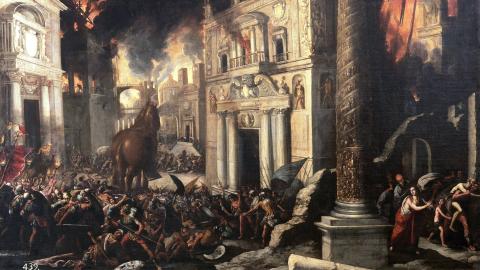Landry du Lauzon
Some are born leaders, some naturally become leaders and some have leadership thrust upon them and then snatched away. Such is the way with Landry du Lauzon, who in series 1 found himself propelled from the rank and file of the Templars to a dizzyingly senior position. In series 2, this trajectory has been reversed, following the revelation of his affair with Queen Joan. Landry, who has always been a natural rebel, headstrong and ever-questioning, now has to adapt to a rapid fall from grace.
An orphan who was raised by nuns, Landry has always felt like an outsider, which makes it all the more jarring to suddenly become one of the main figureheads of the awesomely powerful Templar system. He has to overcome the traumas of his past – including the loss of the Grail many years before – as well as the illicit secrets of his present, to become the leader his brothers need him to be.
In History
While Landry is not based on any one historical figure, he is in many ways the quintessential Templar warrior: devoutly religious, fearless in battle and the veteran of brutal skirmishes which saw many of his brothers slain. One such confrontation on Landry’s CV is the Siege of Acre, which really did happen in 1291. It was one of the most decisive events in the history of the Crusades, and saw the crushing loss of the last major stronghold of the Crusader Kingdom of Jerusalem.
Acre, in modern-day Israel, was taken by the Mamluks, who were fearsome former slaves who’d risen up to achieve political and military supremacy in northern Africa and the Middle East. Many Templars were killed in this savage confrontation, which dealt a huge blow to Christian ambitions in the region.
Yet the Templars also had their share of victories, as you’d expect from a fighting force which has been so mythologised over time. A knight like Landry would have known full well what we was signing up for by joining the Templar order: a life of rigorous discipline, conducted according to stringent rules of etiquette dictating everything from what he would eat (meat was on the menu only sparingly) to what he could wear.
A knight like Landry would have known full well what we was signing up for by joining the Templar order.
According to a testimony by French abbot Bernard of Clairvaux, the knights of this brave new order avoided “impudent words, senseless occupations, immoderate language”, regarded even chess as a vice, and particularly detested casual entertainment, including “mimes, jugglers, storytellers, dirty songs”, which they regarded as “inane follies”.
This absolute dedication to correct conduct extended to the battlefield. As another contemporary chronicler, the Bishop of Acre, put it, the Templars were “lions in war, mild as lambs at home; in the field fierce knights, in church like hermits or monks; unyielding and savage to the enemies of Christ, benevolent and mild to Christians.”
An example of Templar ferocity came during the Battle of Montgisard in 1177. This was a confrontation between Baldwin IV of the Crusader Kingdom of Jerusalem, the “Leper King”, and the legendary Muslim leader Saladin. Baldwin was a mere teenager at the time, stricken with leprosy and vastly outnumbered by Saladin’s forces. And yet, assisted by the Templars – including their Grand Master, Odo de St Amand – the Crusader forces scored a staggering victory over Saladin.
An eyewitness account, as recorded by chronicler Ralph of Diss, described how the Templars charged “as one man” and “incessantly knocked down, scattered, struck and crushed.” Even the enemy was impressed: “Saladin was smitten with admiration, seeing his men dispersed everywhere, everywhere turned in flight, everywhere given to the mouth of the sword.”
Knightfall’s Landry would have learnt to fight in this incredibly single-minded way, obeying the Templar code even in the messy heat of battle. For example, it was expressly forbidden to break ranks once a military charge was underway. A knight was expected to stay in formation even if injured. They were also expected to carry on fighting, to the death if required, as long as the Templar banner was held aloft
This banner, known as the Beauseant, was a black-and-white flag which served as a beacon and rallying point. Such was its importance that 10 knights would be positioned around it, to ensure it stayed standing and visible throughout a battle.
It was due to these rules that the Templars earnt their reputation as shock troops in the Crusades. As an unnamed pilgrim observer summed up their attitude to war: “In going, they are the first. In returning – the last.”


















